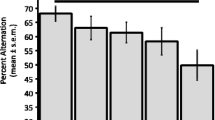Abstract
Seventy volunteers were injected with diazepam (0.3 mg/kg), scopolamine (8 μg/kg), or placebo, followed 70 min later by another injection of physostigmine, physostigmine and methscopolamine (in case of diazepam treatment), or placebo. Physostigmine was given in two doses, 16 and 32 μg/kg; methscopolamine, 8 and 16 μg/kg. Subjects (Ss) were tested in groups of 5 in a double blind procedure with treatments distributed according to a Latin square design. Prior to treatment, Ss heard a series of lists of words, followed by an immediate recall test. Following the first injection, delayed free recall and recognition tests were given. The second drug was then injected, followed by a presentation of another two sets of lists which were tested similarly. Subjective feelings were also evaluated with a rating questionnaire.
Diazepam and scopolamine did not affect recall of information which had been learned prior to drug injection. However, both drugs impaired the learning or acquisition of new information. Physostigmine, especially in its high dose, antagonized most of the memory deficits produced by scopolamine while those of diazepam remained. This is a strong indication that scopolamine acts centrally through an anticholinergic mechanism while diazepam may act through a different system.
Similar content being viewed by others
References
Atkinson, R. C., Shiffrin, R. M.: Human memory: A proposed system and its control processes. In: The psychology of learning and motivation, Vol. 2, K. W. Spence and J. T. Spence, eds., pp. 89–195. New York: Academic Press 1968.
Atkinson, R. C., Shiffrin, R. M.: The control of short-term memory. Sci. Amer. 224, 82–90 (1971)
Baddeley, A. D., Warrington, E. K.: Annesia and the distinction between long-and short-term memory. J. Verb. Learn. Verb. Behav. 9, 176–189 (1970)
Battig, W. B., Montague, E. W.: Category norms for verbal items in 56 categories: A replication and extension of the Connecticut category norms. J. exp. Psychol. Mon. 80, 1–46 (1969)
Consolo, S., Garattini, S., Ladinsky, H.: Action of the benzodiazepines on the cholinergic system. In: Advances in biochemical psychopharmacology, Vol. 14. E. Costa and P. Greengard, eds., pp. 63–80. New York: Raven Press 1975
Consolo, S., Ladinsky, H., Peri, G., Garattini, S.: Effect of diazepam on mouse whole brain and brain area acetylcholine and choline levels. Europ. J. Pharmacol. 27, 266–268 (1974)
Costa, E., Guidotti, A., Mao, C. C., Suria, A.: New concepts on the mechanism of action of benzodiazepines. Life Sci. 17, 167–168 (1975)
Crowell, E. B., Jr., Ketchum, J. S.: The treatment of scopolamineinduced delirium with physostigmine. Clin. Pharmacol. Ther 8, 409–414 (1967)
Deutsch, J. A.: The cholinergic synapse and the site of memory. Science 174, 788–794 (1971)
Drachman, D. A., Leavitt, J.: Human memory and the cholinergic system. Arch. Neurol. (Chic.) 30, 113–121 (1974)
Freemon, F. R., Rosenblatt, J. E., El-Yousef, M. K.: Interaction of physostigmine and delta-9-tetrahydrocannabinol in man. Clin. Pharmacol. Ther. 17, 121–126 (1975)
Ghoneim, M. M., Mewaldt, S. P.: Effects of diazepam and scopolamine on storage, retrieval, and organizational processes in memory. Psychopharmacologia (Berl.) 44, 257–262 (1975)
Greenblatt, D. J., Shader, R. I.: Anticholinergics. New Engl. J. Med. 288, 1215–1219 (1973)
Ishikawa, K., Saito, S.: The possible role of GABA on rats discrimination learning. Abstracts of the Sixth International Congress of Pharmacology, Helsinki 1975, p. 369
Kerkut, G. A., Geoffrey, W. O., Oliver, J. T., Rick, R., Walker, R. J.: The effect of drugs on learning in a simple preparation. Comp. gen. Pharmacol. 1, 473–484 (1970)
Mandel, P., Ebel, A.: Correlations between alteration in cholinergic system and behavior. In: Neurochemistry of cholinergic receptors, E. de Robertis, and J. Schacht, eds., pp. 131–139. New York: Raven Press 1974
Norris, H.: The action of sedatives on brain stem oculomotor systems in man. Neuropharmacology 10, 181–191 (1971)
Penfield, W., Mathieson, G.: Memory. Arch. Neurol. (Chic.) 31, 145–154 (1974)
Schallek, W., Zabransky, F., Kuehn, A.: Effects of benzodiazepines on central nervous system of cat. Arch. int. Pharmacodyn. 149, 467–483 (1964)
Thorndike, E. L., Lorge, L.: The teacher's word book of 30,000 words. New York: Columbia University Press 1944
Author information
Authors and Affiliations
Rights and permissions
About this article
Cite this article
Ghoneim, M.M., Mewaldt, S.P. Studies on human memory: The interactions of diazepam, scopolamine, and physostigmine. Psychopharmacology 52, 1–6 (1977). https://doi.org/10.1007/BF00426592
Received:
Accepted:
Issue Date:
DOI: https://doi.org/10.1007/BF00426592




